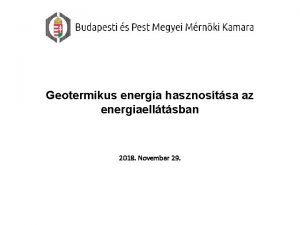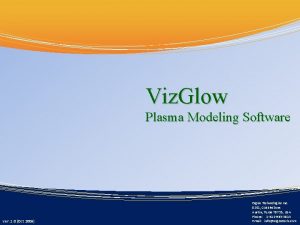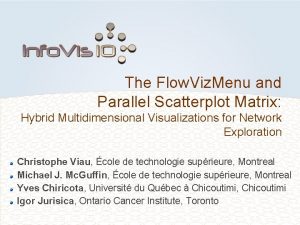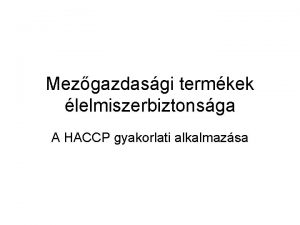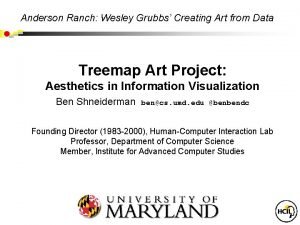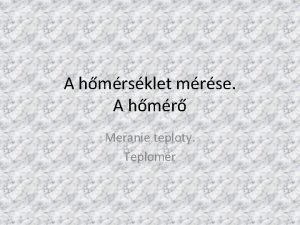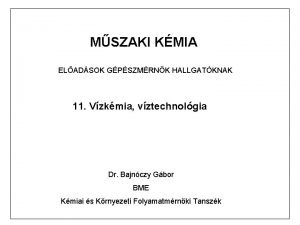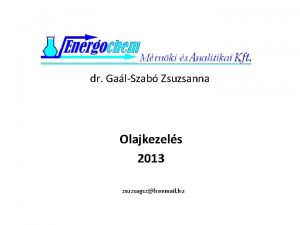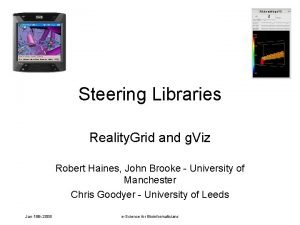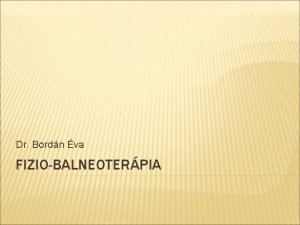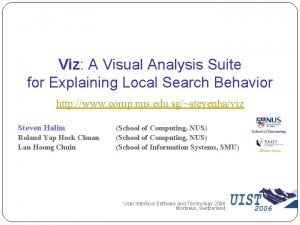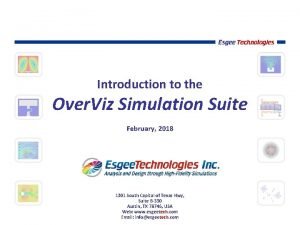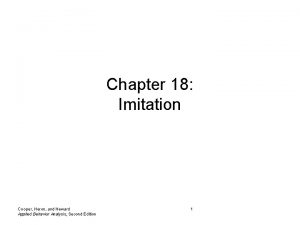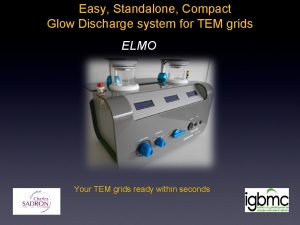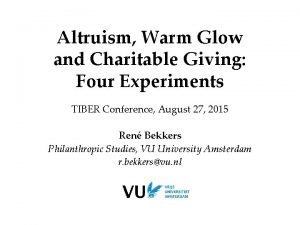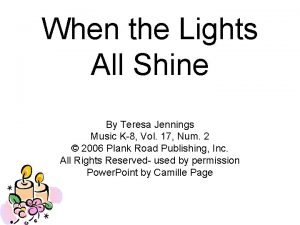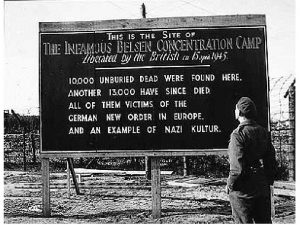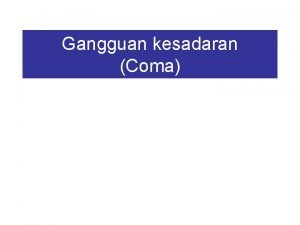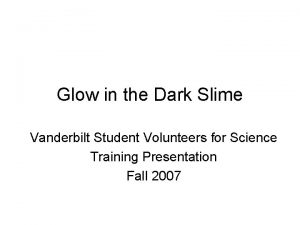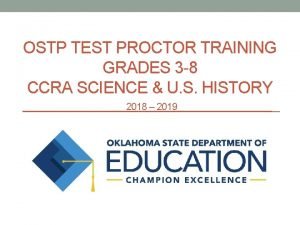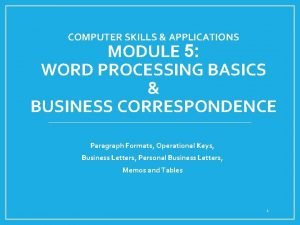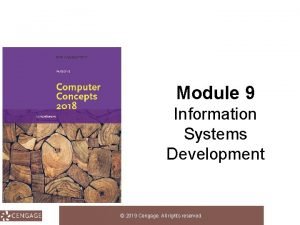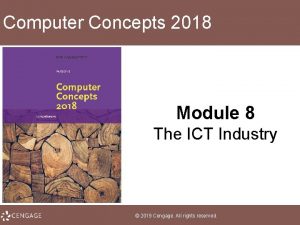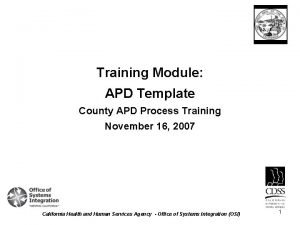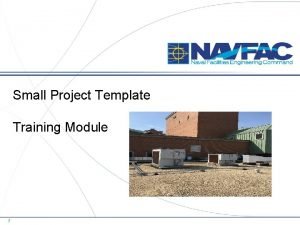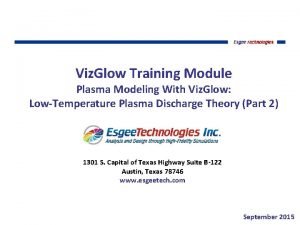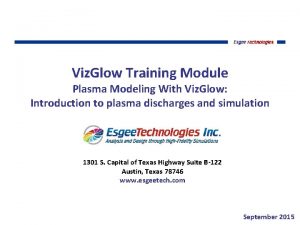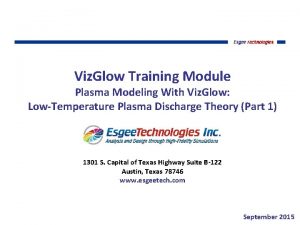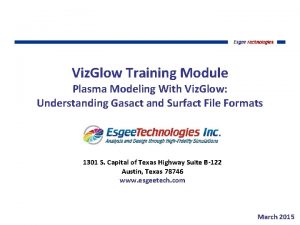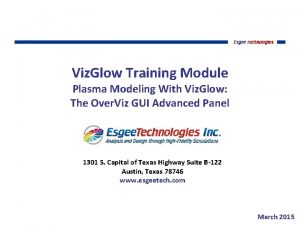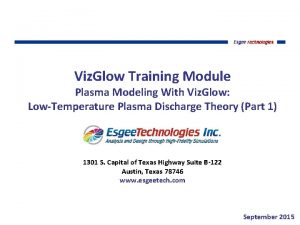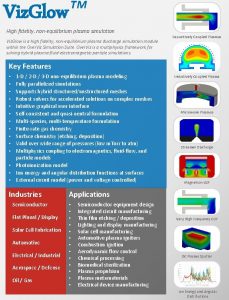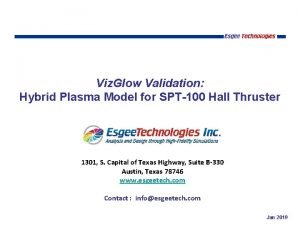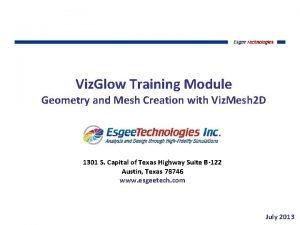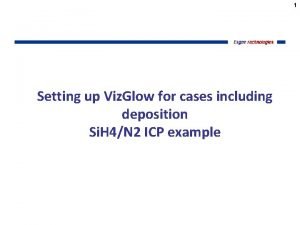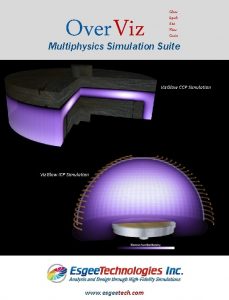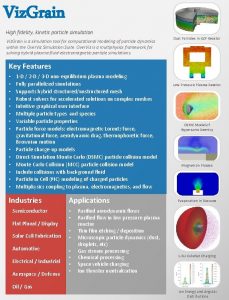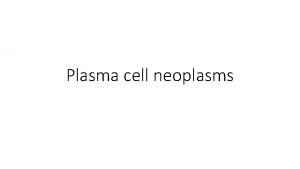Viz Glow Training Module Plasma Modeling With Viz





























































- Slides: 61

Viz. Glow Training Module Plasma Modeling With Viz. Glow: Introduction to plasma discharges and simulation 1301 S. Capital of Texas Highway Suite B-122 Austin, Texas 78746 www. esgeetech. com September 2015

2 COPYRIGHT AND CONFIDENTIALITY STATEMENT Copyright © (2007 -2015) Esgee Technologies, Inc. All rights reserved. This manual accompanies software that is provided to users under a license agreement. This manual can also be provided under a non-disclosure agreement and is subject to restrictions on confidential information under such an agreement. The manual contains proprietary information and may not be disclosed to a third party not covered by the license agreement or a non-disclosure agreement. No part of this manual may be reproduced in any form or by any means without express written permission from Esgee Technologies, Inc.

3 Introduction to plasma discharges

4 States of matter Solid Intermolecular PE >> Thermal energy (KE) of molecules Liquid Intermolecular PE >> Thermal energy (KE) of molecules Gas Intermolecular PE << Thermal energy (KE) of molecules Plasma Intermolecular PE << Thermal energy (KE) of molecules

5 From gas to plasma “Hot” and “Cold” plasmas Thermal plasmas (“Hot”) Produced when gases are at extremely high temperature (~10000 K and more) All species can be characterized by the same temperature (in thermal equilibrium) Non-thermal plasmas (“Cold”) Produced when electrical power is supplied to gases (gas breakdown), power is mainly absorbed by electrons Electrons have high temperature (~10000 K and more) Ions and Neutrals remain at lower temperature (~300 -1000 K) Not in thermal equilibrium (non -equilibrium plasma) Image Credit: Hinode JAXA/NASA, Public Domain Image Credit: Will Folsom, CC BY 2. 0

6 Plasma constituents (1/2) Charged particles - Electrons Ions + Positively charged ions negatively charged ions -

7 Plasma constituents (2/2) Neutral particles Neutrals Ground state molecules and atoms Excited atoms and molecules Electronically excited atoms and molecules Metastable (long-lived) atoms and molecules (lifetime 1 ms-1 s or more) Short-lived (emit light upon de-excitation) (lifetime ~ 10 -8 s) excitation Photon (hv) de-excitation Rotationally excited (molecules) Vibrationally excited (molecules) A X

8 Plasmas- defining characteristics What makes a plasma? Quasi-neutrality Number of positive charge carriers ~ Number of negative charge carriers Plasma density: number of charge carriers per unit volume Thermal energy (KE) of molecules >> Intermolecular PE Collective behavior Debye length << Length scale (extent) of plasma Large number of charged particles in a “Debye sphere”

9 Debye length (1/2) When a charged particle is introduced into vacuum, its electrostatic potential is felt to very large distances (Coulomb potential) vacuum When a charged particle is introduced into a plasma, the potential field is affected by surrounding plasma and becomes effectively zero beyond a certain length scale plasma

10 Debye length (2/2) The Debye length is the distance over which the electric field of a charged particle is felt by other charged particles in a plasma (Debye shielding) vacuum plasma

11 Plasma frequency Let us suppose a slab of charged species with equal number of positive and negative charges If the negative species in the slab are moved, a restoring force returns the slab to its original state The characteristic frequency associated with the oscillations from the restoring force is the plasma frequency, eg. For electrons

Different types of plasmas, characteristic density and temperature High density Image Credit: USAF Edward Aspera Jr. , Public Domain Image Credit: Pslawinski, CC BY SA 2. 5 Image Credit: High Contrast, CC BY 3. 0 DE Image Credit: Ralf Schumacher, CC BY-SA 3. 0 Image Credit: Hinode JAXA/NASA, Public Domain Image Credit: Will Folsom, CC BY 2. 0 High temperature Adapted from : NRL plasma formulary http: //wwwppd. nrl. navy. mil/nrlformulary/ 12

13 Electron Debye length and plasma frequency: typical values Electron density (#/m 3) Debye length (m) Plasma Frequency (Hz) CCP ICP DCD MWP APP MD, DBD CCP: Capacitively Coupled Plasma ICP: Inductively Coupled Plasma MWP: Microwave Plasma APP: Atmospheric Pressure Plasma DCD: Direct Current Discharge MD: Micro-discharge DBD: Dielectric Barrier Discharge

14 Plasma discharges- bulk and sheath A plasma generated in a laboratory setting is referred to as a plasma discharge (or gas discharge) E A plasma discharge is characterized by a bulk region that is quasi-neutral, and sheath regions near boundaries that have a net space charge density The electric fields created by the presence of the sheath region restrict the motion of electrons towards the electrodes, thus keeping electrons in the bulk region The presence of the sheath maintains quasi-neutrality in the bulk plasma

Charged particle motion in electric and magnetic fields Electric field + - Magnetic field (cyclotron motion) + - 15

16 Cold plasma electrons are more strongly confined by a magnetic field Magnetic field (cyclotron motion) + Example: Cyclotron (Larmor) radius and frequency for electrons and ions in a cold plasma discharge, B 0 = 100 G Species e- 9. 1 x 10 -31 2 8. 39 x 105 0. 48 280. 18 H+ 1. 67 x 10 -27 0. 026 2. 23 x 103 2. 32 0. 1527 Ar+ 6. 64 x 10 -26 0. 026 3. 54 x 102 14. 7 0. 0038

Electron dynamics in the presence of an electric field Electrons gain energy from Electric field - Electrons collide with neutrals (or ions, other electrons) - + collision 17

18 Collision processes in plasmas Gas phase: Electron impact reactions Elastic collision: Kinetic energy is conserved Inelastic collision: Kinetic energy is not conserved (Total energy is always conserved) - - elastic excitation (rotational, vibrational, electronic) (momentum transfer) - - dissociation ionization + attachment - recombination +

19 Collision processes in plasmas Gas phase: Ion and neutral reactions Ion-ion reactions + Recombination Ion-neutral reactions Charge exchange (resonant/nonresonant) Detachment Neutral-neutral reactions Chemi-ionization Other chemical reactions - recombination + charge exchange detachment + ionization - + -

Collision processes in plasmas Gas phase reaction examples (1/2) Argon example reactions Species: e-, Ar+, Ar*, Ar Reaction Type e- + Ar* e- + Ar 2 e- + Ar+ e- + Ar* 2 e- + Ar+ Ar* + Ar* e- + Ar+ + Ar e- + Ar* e- + Ar Ar* + Ar* Ar + Ar Electron impact excitation Electron impact ionization (direct) Electron impact ionization (stepwise) Chemi-ionization Collisional de-exciation Collisional de-excitation 20

Collision processes in plasmas Gas phase reaction examples (2/2) Oxygen example reactions Species: e-, O+, O 2+, O-, O 2 -, O, O 2(1∆g) Reaction Type e- + O 2 e- + O 2(1∆g) e- + O 2 2 e- + O 2+ e- + O 2 e- + 2 O e- + O 2 O- + O e- + 2 O 2 O 2 - + O 2 O + O 2+ O+ + O 2 e- + O 2+ 2 O O- + O 2+ O + O 2 Electron impact excitation Electron impact ionization (direct) Electron impact dissociation Dissociative attachment Three-body attachment Charge exchange (charge transfer) Dissociative recombination Ion-ion recombination 21

22 Collision processes in plasmas Surface reaction examples Quenching: Ion impacts the surface, gains charge from the bulk material and returns as its parent neutral Deposition Chemisorption with dissociation: radical molecule impacts surface, depositing one of its constituent atoms Etching Adsorption of etchant, followed by reaction and subsequent desorption + +

23 Collision processes in plasmas Surface reaction examples Argon plasma on Copper surface reactions Species: example e-, Ar*, Ar+, Cu+, Cu(S), Cu(B) Reaction Type e- Ar* Ar Ar+ + #Cu(B) #Cu + Ar Cu(B) Cu+ Cu(B) Electron quenching Metastable quenching Ion sputter/etch Deposition

Power deposition mechanisms in plasma discharges Collisional Joule heating: Collisionless (stochastic) heating: - high pressure collisional gas electrons accelerate in E fields to gain kinetic energy collisions randomize electron kinetic energy to thermal energy B fields do not deposit power - - low-pressure weakly-collisional gas electrons accelerate in oscillatory E fields to gain kinetic energy if E field is spatially varying then electron kinetic energy is randomized due to loss of phase coherence between electron motion and E field oscillation (effectively heats electrons) 24

Power deposition and loss pathways in plasma discharges 25 Power deposition from plasma Source (E field) Joule heating Stochastic heating Joule heating Ion energy pool Collisions with surfaces Outflow (pump) Ion energy losses Electron energy pool Elastic collisions Neutral energy pool Collisions with surfaces Outflow (pump) Neutral energy losses Inelastic collisions Collisions with surfaces Outflow (pump) Electron energy losses

26 Electronegative plasma discharges At least one negative ion, in addition to electrons and positive ions Electropositive discharge ion-electron bulk plasma + sheath Electronegative discharge ion-ion core + electron-ion edge plasma + sheath negative ions strongly confined in bulk due to electron confining ambipolar E fields electric potential self-shielding not as effective; large E fields in the bulk most of the power deposition is due to Joule heating in the bulk rather than sheath-bulk interface Electropositive plasma density positive ion Electronegative plasma positive ion negative ion density electron ion-ion core electron-ion plasma sheath electron-ion plasma

27 Plasma sources Direct Current Discharges (DCD) Capacitively Coupled Plasmas (CCP) Inductively Coupled Plasmas (ICP) Microwave Plasmas (MWP)

28 Direct Current Discharges (DCD) Ions accelerated in the sheath region towards the cathode surface Excited species also diffuse towards the cathode surface On impact, secondary electrons generated at cathode (Auger process) Electrons are accelerated by the sheath electric fields reach the sheath edge resulting in electron impact excitation/ionization Secondary electron emission processes are necessary to sustain discharge Low-density plasmas (109 -1010 cm-3) E Potential +

29 Capacitively Coupled Plasmas (CCP) Oscillatory E fields result in more efficient power coupling to plasma Sheath width oscillates over RF cycle Electrons oscillate within the ion cloud, and are lost to the boundary in short pulses during the cycle when the sheath potential is zero secondary electron (wall processes) not as important low-density plasmas (1091011 cm-3) potential E

30 Magnetron CCPs (1/2) Electrons trapped along field lines; improved hot electron confinement; improved uniformity Stable plasma at very low pressures Collapse of positive sheath structure with decrease in cross field electron mobility Loss of self-shielding effect; inverted sheath structure Bulk plasma E fields are stronger because of sheath collapse Increased resistivity of discharge (ions are important current carriers) B E no B field potential with B field

31 Magnetron CCPs (2/2) Increased sensitivity to secondary electron emission on powered electrode Increased confinement of ionization/excitation sources near powered electrode Decreased dc negative bias when powered electrode has a blocking capacitor Decrease in ion impact energies when B field is included Effect of magnetic field on the IEDF With 80 G magnetic field E No magnetic field B

32 Inductively Coupled Plasmas (ICP) RF coils generate EM field Induced E field deposits power to electrons through collisional/stochastic heating power deposition within skin depth induced B field has no significant consequence on charge particle dynamics relatively high-density plasmas (1010 -1012 cm-3) B E

Microwave Plasmas (MWP) Example: Radial line slot antenna Microwaves create a standing wave pattern in a dielectric wave plate Antenna transmits radiation to Microwaves window Antenna Standing wave pattern also established Wave plate in window Window Electric fields penetrate region at the Plasma window-plasma chamber interface and heat electrons, that in turn generates the plasma ions and radicals For plasmas above a certain density, most of the power absorption by Microwave source: Radial line slot antenna electrons typically occurs in a small region (within the skin-depth) Ions and radicals diffuse to the surface Typical plasma density ~ 1011 -1012 cm-3 33

34 Microwave Plasmas (MWP) Example: Electron Cyclotron Resonance (ECR) Microwave (GHz) for ECR heating of electrons through resonance with electron cyclotron motion no skin depth limitations to heating very high-density plasmas (1011 -1014 cm-3) microwave X X resonance (source) zone B X diffusion zone electron cyclotron resonance

Summary: A typical plasma discharge setup 35 EM Wave Source(s) (ICP coils/Microwave) Gas Flow Non-equilibrium Plasma Magnetic Fields Gas Chemistry Surface Chemistry External Circuit Dynamics

36 A brief overview of plasma modeling and simulation

Formulation of a mathematical model of plasma discharges (1/3) Maxwell’s equations for electric and magnetic fields Faraday’s law of Induction: Ampere’s law: Gauss’ law for magnetic fields: 37

38 Formulation of a mathematical model of plasma discharges (2/3) Charged species atoms/molecules (“particles”) in the plasma move according to forces exerted by the EM fields, + + satisfying Newton’s second law of motion -

Formulation of a mathematical model of plasma discharges (3/3) As plasma particles move, they collide with other particles, resulting in transfer of momentum, energy and creation/destruction of particles Choosing a frame of reference Each species is governed by a Boltzmann equation (a continuity equation for the species distribution function) Particle motion can also be treated by applying Newton’s second law on a molecular level, with statistical treatment of collision processes (PIC-MCC) 39

40 Distribution functions A distribution function is defined as = number of particles inside a six dimensional phase space volume at location and time

From distribution functions to Macroscopic quantities can be obtained by taking moments of the distribution function Number density Mean velocity Mean energy density 41

The Boltzmann equation and fluid equations The Boltzmann equation is a continuity equation in phase space with the species distribution function as the dependent variable A fluid model of plasmas can be obtained by taking moments of the Boltzmann equation The resulting equations are the conservation of mass, momentum and energy of each species ((1+D+1)Nspecies equations, eg 5 Nspecies equations for 3 -D case) 42

43 A fluid model of plasma discharges For weakly ionized plasma discharges, reasonable approximations are made to reduce the number of governing equations being solved into the following set: Conservation of mass Species continuity equations for each plasma species (with a background gas density constraint) Background density from ideal gas law, or by solving Navier-Stokes equations Conservation of momentum Drift-diffusion approximation for electrons (neglecting inertial effects) Ion momentum equation for all ions, or Driftdiffusion approximation for all ions Drift-diffusion approximation for neutrals (except background) Conservation of energy Electron energy equation Bulk energy equation (single equation for all ions and neutrals)

44 Closure of the plasma fluid model equations The transport and rate coefficients can be obtained analytically by assuming a distribution function (eg. Maxwellian distribution for ions and neutrals) Solving the zero-dimensional Boltzmann equation numerically to create look-up tables for transport and rate coefficients as functions of the mean energy, which can then be used in the fluid model (eg. For electrons, where the distribution function is not known/not equilibrium) EEPF (e. V-3/2) The resulting fluid equations contain transport coefficients and reaction rate coefficients, which need to be specified to solve the equations Energy (e. V) EEPFs in argon, mean energy 3 e. V Red dashed line: Maxwellian Blue solid line: Numerical solution of zero-dimensional Boltzmann equation

Model approaches for plasma discharges: Governing equations First-principles Self-consistent model + EM Self-consistent model Quasi-neutral model Boltzmann’s equation Moment (Fluid) Equations Average over velocity space EM field effects not as important Maxwell’s equations Poisson’s equation Space charge effect not as important All species except electrons Quasi-neutrality constraint; charge continuity constraint Relative ease of numerical solution Most difficult Least difficult 45

Fluid model: self-consistent and quasineutral formulations Self-consistent Poisson equation is solved to find the electrostatic potential (Gauss’ law) : Quasi-neutral Ion density equations are solved, and electron density recovered with the quasi-neutrality constraint: Ambipolar potential equation is solved: 46

Choosing between self-consistent and quasi-neutral formulations Self-consistent Quasi-neutral CCP Yes - ICP Yes ICP+RF bias Yes - MWP Yes MWP+RF bias Yes - DC Yes - Self-consistent Required when there is a sheath that needs to be resolved (CCP, RF bias, DC) More difficult to solve numerically (Adds numerical stiffness to the system) Quasi-neutral Can be used when the plasma density is high, and the sheaths are very thin (ICP, MWP) Easier to solve numerically compared to self-consistent formulation (Numerically less stiff; allows for larger time-steps) 47

Plasma fluid model equations are convection-diffusion-source PDEs Generic convection-diffusion-source PDE Example: electron continuity equation Example: electrostatic potential equation Numerical algorithms for convection-diffusion-source PDEs have been extensively studied and used in various fields Time-step size and spatial mesh-spacing requirements for stability, accuracy and convergence of plasma model equations can be obtained from standard convection-diffusion-source PDE analysis 48

Plasma equations have large variations in time steps for stability Electron-Poisson sub-system Electrostatic potential Electron density Electron energy Ion sub-system Ion density Neutral sub-system Neutral density Characteristic time step 49

50 Time step skipping Skipped steps End time is same for electrons and neutrals Neutral equations are not solved at every electron time step t = tbegin electron time steps t = tend neutral time steps t = tend dt t = tbegin Nskip*dt

51 Time step multipliers (1/2) Time step multipliers End time is not same for electrons and neutrals Neutral equations are solved at every electron time step t = tbegin electron time steps t = tend neutral time steps t = dtmult*tend dt t = tbegin dtmult*dt

52 Time step multipliers (2/2) t = tbegin electron time steps t = tend dt t = tbegin neutral time steps dtmult*dt t = dtmult*tend

53 Time step skipping and multipliers Time step skipping with multipliers End time is not same for electrons and neutrals Neutral equations are not solved at every electron time step t = tbegin electron time steps t = tend neutral time steps t = dtmult*tend dt t = tbegin Nskip*dtmult*dt

Effect of Time step multipliers on steady state results Verification to test if using different time-step multipliers results in the same steady state result showerhead axis topwall sidewall Gas wafer pump Simple CCP example (simple. CCP) Gas: Ar Pressure (Pa): 6. 66 (= 50 m. Torr) Supply Control Type: Voltage control Fixed voltage waveform (V): 100. 0*SIN(2*PI*(100. 0*E(6))*T) Time step multiplier for neutrals: 1, 100, 1000 54

Results: Electrostatic Potential and Electron Temperature Time step multiplier neutral (TSM_N) TSM_N = 1000 Steady state values show excellent agreement Each case takes different amount of time to reach steady state 55

56 Results: Argon ion and metastable density Time step multiplier neutral (TSM_N) TSM_N = 1000 Steady state values show excellent agreement Each case takes different amount of time to reach steady state

Volume Point Transients at Wafer Center Electron and metastable density Electrons AR* Each case takes different amount of time to reach steady state 57

Volume Point Transients at Wafer Edge Electron and metastable density Electrons AR* Each case takes different amount of time to reach steady state 58

Summary: Plasma fluid model equations Self-consistent model Electrostatic potential Species density Drift-diffusion (transport) Ion momentum Electron energy Bulk energy 59

Summary: Plasma fluid model equations Quasi-neutral model Ambipolar electric field Ion and neutral species density Drift-diffusion (transport) Electron density (quasi -neutrality constraint) Electron energy Bulk energy 60

End of presentation www. esgeetech. com
 Víz-víz hőszivattyú vízigénye
Víz-víz hőszivattyú vízigénye Plasma simulation software
Plasma simulation software Helen erickson nursing theory
Helen erickson nursing theory Relational vs dimensional data modeling
Relational vs dimensional data modeling Flow viz
Flow viz Tartósítási eljárások csoportosítása
Tartósítási eljárások csoportosítása Tenzió fogalma
Tenzió fogalma Fin viz map
Fin viz map Hőmérők fajtái
Hőmérők fajtái Víz vastalanítása
Víz vastalanítása Viz is neis
Viz is neis Durranógáz
Durranógáz Víz fázisdiagramja
Víz fázisdiagramja Hínárnövények
Hínárnövények G-viz
G-viz Hidroszféra részei
Hidroszféra részei Antiphlogistin pakolás
Antiphlogistin pakolás Viz online suite
Viz online suite Víz keletkezése
Víz keletkezése Viz online suite
Viz online suite C device module module 1
C device module module 1 Unplanned model aba
Unplanned model aba Kentucky glow caverns
Kentucky glow caverns Health and glow company profile
Health and glow company profile Glow sticks of steel
Glow sticks of steel Green glass globes glow greenly
Green glass globes glow greenly Glow discharge tem grids
Glow discharge tem grids Warm glow altruism
Warm glow altruism Darvel primary school staff
Darvel primary school staff Minipcr dna glow lab answers
Minipcr dna glow lab answers Emigree poem analysis
Emigree poem analysis Imagery in she walks in beauty
Imagery in she walks in beauty Glow stick lab
Glow stick lab Echinops bannaticus the giant
Echinops bannaticus the giant Blender glow texture
Blender glow texture Kamoteng kahoy go grow glow
Kamoteng kahoy go grow glow Glow teresa jennings
Glow teresa jennings Tiny glow-worm tenderness
Tiny glow-worm tenderness Thank you for listening to my presentation
Thank you for listening to my presentation Glowgurt
Glowgurt The graceful slopes glow even clearer
The graceful slopes glow even clearer Identical rhyme examples
Identical rhyme examples Rev blinkin
Rev blinkin Glow-worms
Glow-worms Yaunkauer
Yaunkauer Glasgow coma scale adalah
Glasgow coma scale adalah In mrs tilscher's class annotated
In mrs tilscher's class annotated Glow inthe dark
Glow inthe dark The graceful slopes glow even clearer
The graceful slopes glow even clearer Teamwork training module
Teamwork training module Sbcc training module
Sbcc training module Ostp ta training module
Ostp ta training module Hbnc and hbyc
Hbnc and hbyc Module 5 computer concepts skills training
Module 5 computer concepts skills training Module 2 computer concepts skills training
Module 2 computer concepts skills training Module 11 computer concepts exam
Module 11 computer concepts exam Us army 8 step training model
Us army 8 step training model Training module template
Training module template Training module template
Training module template Kaizen training module
Kaizen training module Do amway ditto/cvr
Do amway ditto/cvr Teamwork training module
Teamwork training module
